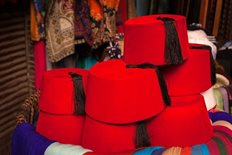
The inimitable red fez with its black tassel is an enduring symbol of the mysterious east in art and film, and on formal occasions in Morocco where it is still considered an essential part of what the well-dressed/well-connected man is wearing. In North America, it is most often associated with the Masonic group of the Shriners who sport it as part of their Middle Eastern-themed parade kit.
The iconic red felt hat, which is also known as a “tarboosh” originated in the Moroccan city of Fes (note that F-E-S is the city, while F-E-Z indicates the headgear). Legend says that in the 10th century, during a time of great chaos in the Middle East, attempts by the Muslim faithful to perform the obligatory pilgrimage to Mecca were interrupted by Bedouin attacks. Around 980 CE, a group of pilgrims who could not reach Mecca re-routed to Fes which was quickly designated as a substitute Holy City. There, the pilgrims adopted the distinctive red felt conical hat of the city, and soon throughout North Africa and the wider Islamic world it became a badge of distinction, denoting someone of good education and refined sensibilities.
It was in the 19th century that the fez took on the strong political connotation it enjoyed for almost one hundred years. In 1826, the reforming Sultan Mahmud II of the Ottoman Empire introduced the fez as a modern update from the traditional turbans of the traditional and by-then intensely corrupt Janissaries. In one fell swoop, the Sultan reduced hierarchical civil service and military uniforms in the vast empire to an egalitarian way of dress. The fez fad once again spread throughout the Middle East and to parts of Asia and India. It was worn as part of military dress in the Turkish, colonial African/Italian and Greek armies, and is still a part of many of their parade uniforms.
In the West, the fez was adopted by literary, artistic, and bohemian men as part of a quixotic sartorial style and famously adopted by the Masonic brotherhood subgroup of the Shriners, who still enthusiastically sport the fez today during parades and formal occasions.
The fez was outlawed in Turkey by the founder of that country's modern iteration, Mustafa Kemal Ataturk in 1925; but in Morocco it remained a symbol of national independence and a protest against French colonialism. It has endured in that country as part of the national identity, worn on formal occasions by government officials and military high-brows. And, of course, the likes of Señor Ferrari in
Casablanca, Anthony Blanche in
Brideshead Revisited and the Eighth
Doctor Who stated “I wear a fez now, fezzes are cool.”
Find the Fes that fits you best on one of Alexander + Roberts's distinctive journeys to Morocco, such as
The Magic of Morocco, always capped at 16 guests for your maximum enjoyment.